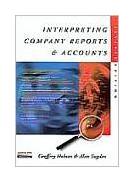Published accounts are often not easy to understand and are sometimes downright misleading
but, to those who know how to read them, they provide the most readily available source of
information on a company's activities, its profitability and its prospects. This book
guides the reader through the conventions and complexities of reports and accounts,
explaining how to assess the financial and trading position of a company from year to
year, how to spot undue risk-taking, where and how to look for clues on the quality of
management and how to detect where window-dressing has been used to disguise poor results.
In 1990 the authors wrote:
'Company accounting is currently in a state of flux, confusion and controversy'. It is
now in much better shape. In ten years, 15 Financial Reporting Standards (FRSs), countless
Financial Reporting Exposure Drafts (FREDs), a host of other documents, and, for the first
time in the UK, an exposure draft Statement of Principles of Financial Reporting have been
produced by the Accounting Standards Board (ASB). Many earlier abuses have been prevented,
and much more information now has to be disclosed, the use and purpose of which the
authors seek to explain. But work still needs to be done. The final chapter of this
edition examines the problems that remain, and the steps the ASB is taking to resolve
them.
The seventh edition has been
fully updated to take account of the latest amendments in accounting rules. Reports and
accounts have improved immeasurably over the last 20 years, and especially over the last
ten. There is now so much information that it has become difficult to find one's way
through the maze. To demonstrate the art or skill of picking one's way through a mass of
data, Chapter 31: 'Putting it all together' takes readers step by step through the
report and accounts of a well-known group (THE BODY SHOP).
Key Features
Highly practical text
End-of Chapter discussion questions and practical exercises
Chapter 31 "Putting it all together" takes readers step by step through the
report and accounts of a well know group (The Body Shop)
Thorough updating to reflect new
standards.
Examples on current practice will be updated to reflect accounts dated 1998 or 1999. The
authors' own examples will be dated 2000. 70% of the examples will be reset.
Improved coverage of International Accounting Standards, including a one or two page table
of international differences.
Include a new chapter
(short) to conclude, on using accounts and other information to choose the right
portfolio. This would round off the text and give a more practical feel to the book.
Revise the section on information available on the Internet and include URLs.
Contents
INTRODUCTION -
1 Company reports and accounts - an introduction,
2 Financial reporting standards and principles,
FORMATION -
3 Forming a company,
4 Admission to listing,
THE BALANCE SHEET CAPITAL EMPLOYED -
5 Share capital and reserves,
6 Loan capital,
ASSETS: FIXED ASSETS -
7 Intangible fixed assets,
8 Tangible fixed assets,
9 Fixed asset investments,
CURRENT ASSETS -
10 Stocks and work in progress,
11 Debtors, 12 Current asset investments, cash at bank and in hand,
CURRENT LIABILITIES -
13 Bank loans and overdrafts,
14 Derivatives and other financial instruments,
15 Creditors, provisions, contingent liabilities and contingent assets,
THE PROFIT AND LOSS ACCOUNTING -
16 Profit and loss account,
17 Taxation,
18 Profit attributable to ordinary shareholders, dividends and earnings per share,
CASH FLOW -
19 Cash flow statements,
THE GROUP -
20 Subsidiaries and group accounts,
21 Acquisitions and mergers,
22 Associated joint ventures and related parties,
OTHER -
23 Foreign exchange,
24 Historical summaries, ratios and trends,
25 Chairman's statement, operating and financial reviews and directors' report,
26 Corporate governance and the auditors' report,
27 Interim statements,
28 Other sources of information,
29 Inflation accounting,
30 Generally accepted accounting principles: UK v US GAAP,
31 Putting it all together,
32 Pro-forma guide to analysis, 33 Future developments in accounting -
Appendices -
Index
About the Author
Geoffrey Holmes, FCA, FTII retired after more than 20 years as editor of Accountancy, the
Journal of the Institute of Chartered Accountants in England and Wales, to devote his time
to investment research. He has lectured and written regularly on the interpretation of
reports and accounts for many years. He is co-author, with Robin Dunham, of the companion
volume Beyond the Balance Sheet.
Alan Sugden is a graduate of
the Royal Naval Staff College, Greenwich, and a Sloan Fellow of the London Business
School. He spent 20 years in the City as an analyst and fund manager, running the then
Ł100m (now Ł850m) Schroder Recovery Fund for several years. He is a former director of
Schroder Investment Management.
320 pages
Księgarnia nie działa. Nie odpowiadamy na pytania i nie realizujemy zamówien. Do odwolania !.


